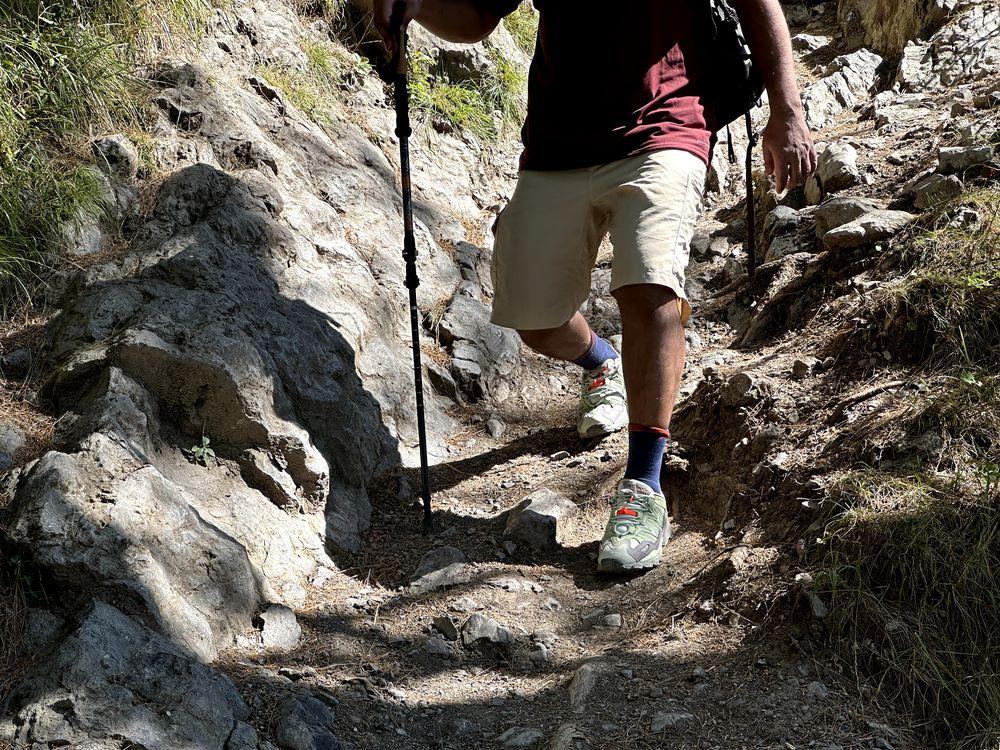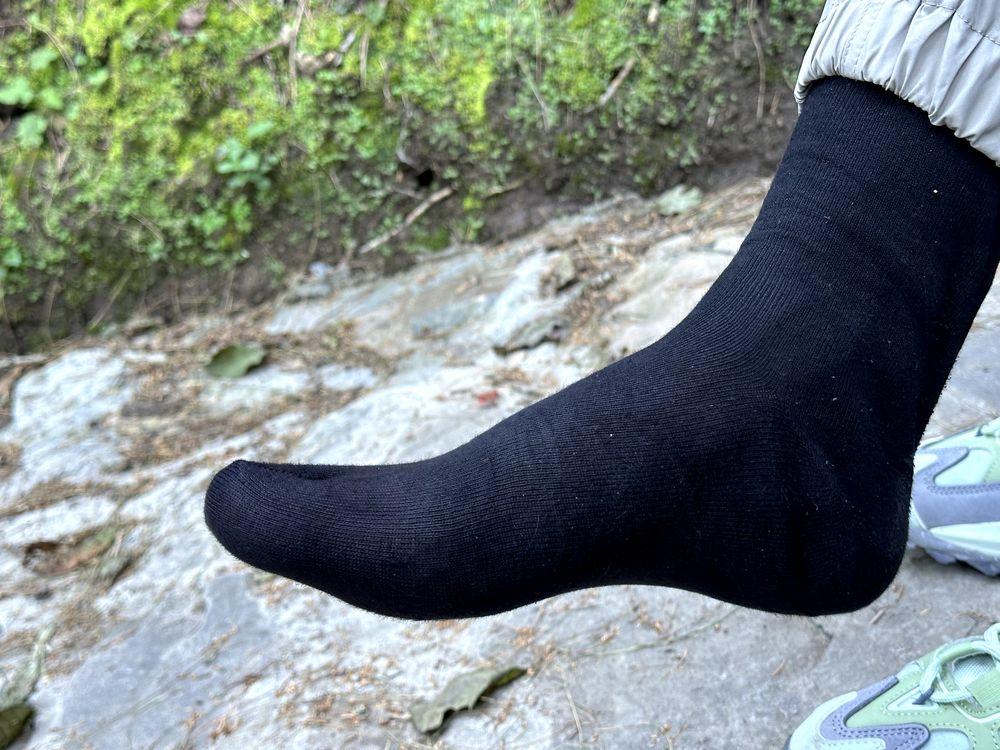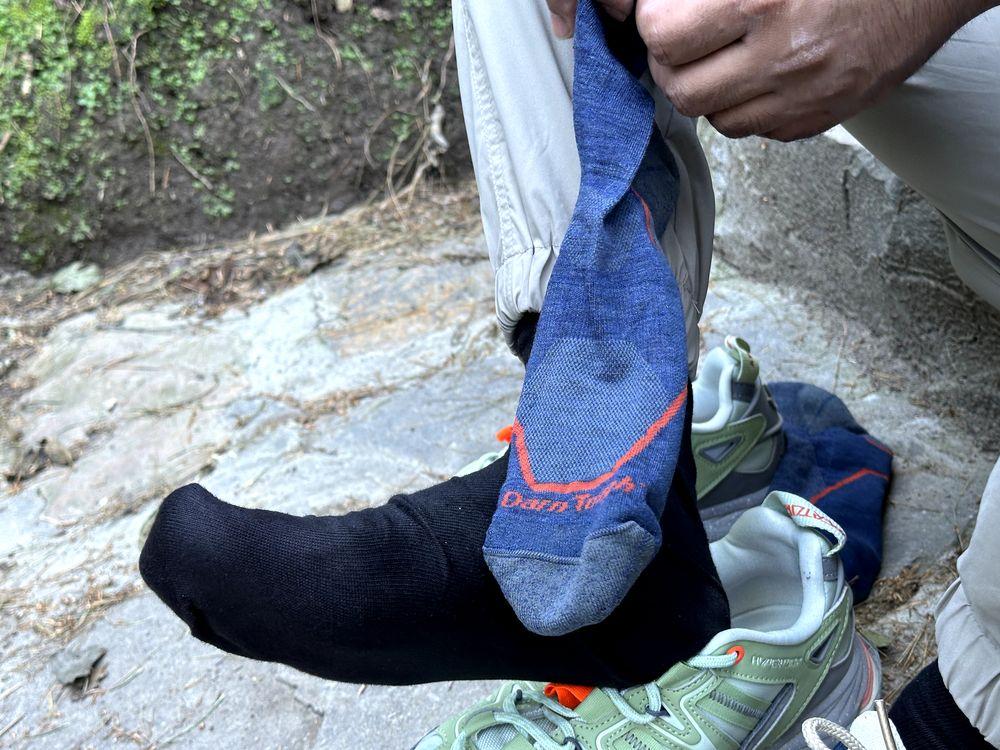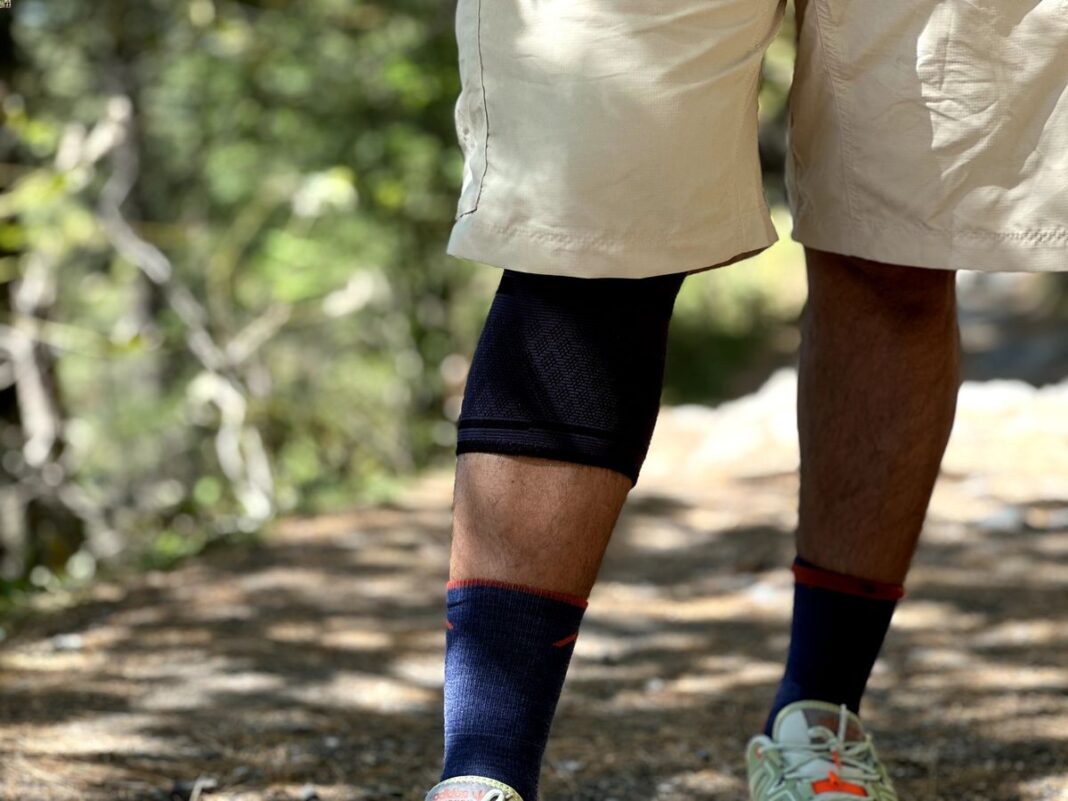Wool is the best material for hiking socks because of its moisture-wicking and temperature-regulation capabilities. These socks absorb sweat and maintain warmth when wet. Merino wool is among the best types of wool. Many renowned wool sock manufacturers use it for premium designs due to its long-lasting, velvety, and finer fibres. Compared with older styles of rag wool socks, Merino wool socks are itch-free. Wool socks combine wool and synthetic materials to boost longevity and drying times.
Related: Is Polyester Good for Hiking?
Here is our comprehensive analysis of different hiking socks materials and a side-by-side comparison. This study is based on our years of backpacking experience wearing wool socks and the opinions of fellow hikers and industry experts.
Comprehensive Analysis of Different Hiking Socks Materials
Wool
Wool socks are popular because they cushion the feet. They help keep feet warm in the winter and cool in the summer. Wool is not very abrasive-resistant; thus, you can use nylon to support the heels and toes.
Wool socks are an amazing insulator because of their natural crimp, which makes them springy and traps air in their millions of coils.

While hiking, your feet may release up to a pint of moisture every twelve hours. So, wool quality impacts how well wool socks perform. High-quality wool keeps its shape when wet. Wrinkled and sagged socks may cause discomfort and blisters.
Merino wool is among the best types of wool. Many renowned wool sock manufacturers, like Smartwool, Darn Tough, and Icebreaker, use it to make quality outdoor socks. These qualities of Merino fabrics increase comfort and durability.
Merino wool socks are perfect for hiking and backpacking trip lovers. The main reason is that they are less stinky than other wool socks.
Merino wool originates from Australia and New Zealand. This material was imported into these countries from Spain in the late 18th century. Merino wool provides brilliant close-to-skin comfort and has an extensive variety of thermoregulation. It does not itch, is far more durable, and insulates when wet. It offers more warmth than synthetic choices after a hot day or time spent in the rain or snow.
Merino wool fibres absorb moisture incredibly well, and they do not smell as bad as synthetic fabrics. Wool is among the best materials for hiking socks; footwear experts recommend it.
Compared with older styles of rag wool socks, Merino wool socks are itch-free. Wool socks combine wool and synthetic materials to boost longevity and drying times.
Polyester
Synthetic socks typically consist of materials such as polyester, acrylic, nylon, and polypropylene. These socks can dry rapidly and soak water faster than wool socks because they absorb a small amount of water.
But they matt down rapidly and are not so warm or comfortable in all kinds of temperatures. Do not wash this material in cold water. Non-absorbent synthetic materials look wet even with a little bit of water.
Synthetic fabric stinks, but silver fabrics like XStatics can reduce it. Organic wool is Odor-resistant. But when you use it for a week, there is a slight smell of wet sheep. Polyester and polypropylene are the best kinds of synthetic fabrics in the socks market.
Polyester fabric has a long life and can dry well in the field but loses its absorbing property at low temperatures. It is also not as warm as merino wool.
Synthetic hiking socks are suitable for warmer temperatures and hiking in fall or spring. For winter, merino wool socks are the best choice.
You can blend polyester with nylon or wool for better durability, warmth, and comfort. Coolmax versions, such as the Darn Tough Coolmax Micro Crew Midweight, offer exceptional breathability for outdoor activities and hiking in hot weather.
Coolmax Eco Made consists of recycled plastic bottles. These socks are one of the best options made of Synthetic materials, so if you are looking for the best eco-friendly choice. Polyester is one of the best alternatives.
Cotton
Cotton socks are not suitable for outdoor adventures and the winter season. The main reasons are moisture absorption, which causes dampness, and you will feel cold.
Related: Why Cotton is Bad for Hiking
When the cotton socks get soaked, they change their shape and form wrinkles, which might cause blisters and discomfort during hiking.

Cotton socks do not have the drying properties and breathability of Synthetic or wool socks. Therefore, it is hard to keep your feet secure and dry.
So, choose moisture-absorbing fabrics for hiking. These include synthetic and wool fibres that keep your feet dry, minimize friction and provide better insulation.
Blend Material
Blend Material Socks are another popular option. These socks consist of fibres like nylon, wool, and spandex. Blend material has benefits like flexibility, better fitting, longevity, and high absorption level capabilities.
Socks made of a mix of materials, such as nylon, spandex, and wool, aim to keep your feet dry while protecting them during lengthy hikes.
Unlike pure cotton socks, which absorb sweat and cause pain, blended material socks help normalize temperature, avoid blisters, and lower the chances of friction.
Nylon is a synthetic choice that can be used as an essential material. It is one of the most common fibers for hiking socks due to its durability and moisture wicking capabilities. Also, it helps to keep your feet comfortable and cool on the trail.
Nylon increases the sock’s durability and makes them far more immune to wear and tear. It allows them to last longer regardless of prolonged use. Its ability to control moisture lessens the chance of blisters and makes nylon-blended socks an ideal choice for hikers.
Spandex: is famous due to its elasticity. It is also a crucial element in mixed hiking socks. Its elasticity allows the socks to hold their shape, which results in a close fit that saves them from falling or bunching up during hiking.

These perfectly fit socks minimize friction, ensuring safety and comfort for a long distance. Spandex also improves the elasticity of the socks, which promotes effortless movement without limiting your adventure, which is critical for being comfortable on challenging trips.
Silk
Silk is a natural insulator that retains moisture, keeps you warm, and maintains its shape. It is used in thin-layer socks and winter-weather socks. To avoid blisters, replace sweaty socks with dry pairs. If you have sweaty feet, change your socks daily, especially during the summer.
Silk is soft and lightweight but lacks the durability needed for hiking. Unlike other materials, it does not provide enough warmth in cold temperatures. However, it is sometimes used in sock liners to provide dependable moisture absorption.
Summary
Wool is the best hiking sock material because of its exceptional moisture-wicking, odor-resistant, cushioning, and comfort capabilities. Merino wool is the highest-quality and most expensive wool. No socks are 100% Merino wool, but socks are made using different materials for quality pairs. Look for socks with more than 50% Merino wool. Polyester fabric has a long life and dries quickly. It’s not as warm and comfortable as Merino wool. Darn Tough Hiker Micro Crew contains 61% Merino wool, the highest-rated wool socks for hiking. Darn Tough Light Hiker Micro Crew is a budget-friendly pair of wool socks containing 43% wool that perform brilliantly on the trail.
